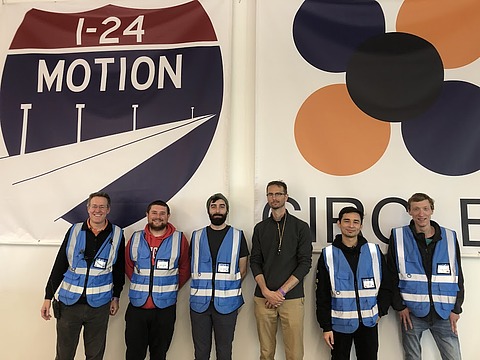The largest live autonomous vehicle traffic experiment ever conducted began the week of November 18, 2022, in Nashville, Tennessee. It involved 100 cars and a workforce of more than 250, around 70 of whom were researchers. One of the goals of the experiment was to analyze how level two autonomous vehicles (think cruise control with a couple of added functions, like speed adjustment that uses LIDAR) can impact traffic waves, specifically those representing frustrating “stop and go” conditions. While this experiment, run by the CIRCLES Consortium, used 4 miles of highway, 288 cameras, and an impressive command center, one of its most vital resources was equations on a blackboard.
In front of one of these blackboards was Benedetto Piccoli, Lopez Chair Professor at Rutgers University - Camden and current Visitor in the School of Mathematics. He thinks of these road networks in terms of graphs, and uses theoretical tools like conservation laws to understand traffic waves (which, when depicted on a graph, look like inverted bells). But beyond just measuring traffic, Piccoli is interested in controlling traffic, as he and his colleagues attempted on a massive scale in Nashville.

This requires a lot of theory. In order to interpret the flow of bulk traffic, you need conservation laws formulated using partial differential equations (PDEs) which help model this complex phenomenon. These interpretations, however, are at a macroscopic level. To make your interpretation of the physical system (cars and infrastructure) and its interaction with a network of agents (drivers) more precise and microscopic, you need to couple PDEs with ordinary differential equations (ODEs). This is a vital step in current models which have become more refined over almost a hundred years of traffic modeling.
Traffic analysis using cameras and conservation laws dates back to the 1930s. Bruce D. Greenshields first used photos of traffic coming out of the Lincoln Tunnel to create a model that he shared in 1933, offering some basic descriptions like traffic flow = density x velocity. He plotted graphs showing a predictable result that as the car density increases, speed decreases. In the 1950s, PDEs came into play: the Lighthill-Witham-Richards model combined density, speed, flow, and partial derivatives with respect to time and space to formulate conservations related to traffic.
However, one of the more important insights you get with a PDE like this is how discontinuities, called “shocks,” travel in time. This is a very clear observable: when you witness cars in stop and go conditions, the “stop” condition moves backward (called a phantom traffic jam). Using the Rankine-Hugoniot condition, which describes the relationship between jumps on either side of a wave, you can compute the speed of the shocks by dividing their upstream and downstream flow by their respective densities.
Solving for these shocks becomes especially complicated when they behave “non-classically,” appearing to violate the entropic conditions of the physical system. These types of shocks are also observed in the fields of elastic and fluid dynamics. At IAS, Piccoli is working with IBM von Neumann Professor Camillo De Lellis on completing theories related to these problems, including those in fluid dynamics, specifically diffusive-dispersive equations related to the non-classical continuities or “shocks” of the same type you see in the traffic models.
It’s important to remember, though, that in Piccoli's case, what these blackboard equations are solving for are more or less human behaviors: that is, drivers expressing themselves in a mathematical language. How, then, can you use mathematics to influence these complex human systems that result in traffic? That’s one of the things the experiment in Nashville aimed to work out.
For this, you need to couple PDEs (describing bulk traffic flow) with ODEs that position your actuators within the flow (the automated cars). This coupled micro-macro model, in addition to control theories, such as the Kalman Filter, allows for the creation of algorithms which, when fed into 2–5% of level two autonomous vehicles, can dissipate traffic waves.
Piccoli, who explicitly works on this applied side of mathematics, is a unique addition to IAS, a theoretically-oriented research institution. This has been a boon, however, to both the scholars at IAS and Piccoli himself: “It’s just almost every day I meet people…and it ranges from people I may even start a collaboration with to people I will probably never collaborate with but I’ve learned so much from,” he said.
He continues, “I’m extremely happy to be here among these great minds, to have the possibility to interact, and see that the Institute has interest in these types of activities.”
After all, these “activities” could have profound real-world effects. Applying these theoretical breakthroughs could result in fewer accidents and less fuel consumption and pollution. Specifically, CIRCLES estimates that reducing negative traffic could result in 10% energy savings. The consortium engages with automotive partners and federal agencies for this purpose.
But more than just offering improvements related to traffic, these mathematical theories also have implications for any large system composed by people, including fields such as economics and public health. It is one of the great examples of how equations on a blackboard are sincerely felt by society.
CIRCLES is led by UC Berkeley and the Institute of Transportation Studies (ITS) Berkeley, in coordination with Vanderbilt University, Temple University, Rutgers University-Camden, the Tennessee Department of Transportation, Toyota North America, and Nissan North America. The funding was provided primarily by the National Science Foundation and the Department of Energy.
This article was originally published on MathInstitutes.org.



